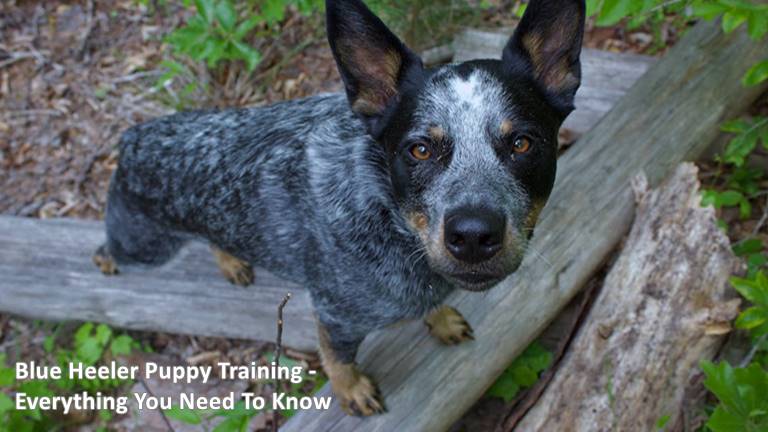Are you considering getting a Blue Heeler puppy or have you recently welcomed one into your home? Blue Heelers, also known as Australian Cattle Dogs, are a highly intelligent and energetic breed that require proper training and socialization to ensure they become well-behaved, happy companions. In this article, we will cover everything you need to know about Blue Heeler puppy training, from basic obedience commands to crate training and more.
Blue Heeler Appearance and Characteristics
Blue Heelers, aka Australian Cattle Dogs, are a highly intelligent and energetic breed that were originally bred for herding cattle on ranches in Australia. This breed was created by crossing various breeds including the Dingo and the blue merle in the 1800s. Blue Heelers are named for their blue-tinged coats and the habit of nipping at the heels of cattle to move them along. They are a medium-sized dog breed, weighing between 35 to 50 pounds, and standing between 17 to 20 inches tall. They have a muscular and compact build, with a broad skull, alert ears, and a dense coat that comes in shades of blue, blue speckled, or blue mottled.
Blue Heeler Temperament
Blue Heelers, also known as Australian Cattle Dogs, have a unique and distinct temperament that sets them apart from other breeds. They were originally bred to work closely with their owners on ranches and are known for their loyalty, intelligence, and high energy levels.
One of the defining traits of the Blue Heeler temperament is their strong-willed and independent nature. They are known to be stubborn and can be difficult to train if their owner is not patient and consistent. However, with positive reinforcement training techniques, they can be trained to be obedient and well-behaved companions.
Blue Heelers are also highly intelligent dogs that require plenty of mental stimulation to stay happy and engaged. They are quick learners and excel at tasks that require problem-solving skills. This intelligence can also make them prone to boredom and destructive behaviors if they are not given enough mental stimulation and exercise.
In addition to their intelligence, Blue Heelers are also known for their high energy levels. They are a working breed that thrives on physical activity and require plenty of exercise to stay healthy and happy. A lack of exercise can lead to behavioral issues such as excessive barking, destructive chewing, and aggression towards other animals.
While Blue Heelers are fiercely loyal and protective of their families, they can be wary of strangers and other animals. It’s important to socialize them from a young age and expose them to a variety of people and situations to prevent them from becoming overly protective or aggressive.
How to Train a Blue Heeler Puppy
If you’re embarking on the exciting journey of Blue Heeler puppy training, it’s essential to get to know your new furry friend first! Understanding their specific breed traits is key to unlocking their full potential and building a happy, healthy bond together. Blue Heelers are an intelligent and active breed that require plenty of exercise, mental stimulation, and socialization to stay happy and healthy. They are known to be fiercely loyal and protective of their families, but can be wary of strangers and other animals. One of the most important things to consider when training a Blue Heeler is their tendency to be independent and strong-willed. This breed was developed to work closely with their owners on ranches and can be stubborn when it comes to following commands. However, with positive reinforcement training techniques, consistency, and patience, Blue Heelers can be trained to be well-behaved and obedient companions.
Blue Heeler Training Commands
Starting training early
Blue Heelers are known for their independence and strong-willed nature. To set them up for success, it’s important to begin their training at a young age. This will help them learn good habits and become well-behaved adults.
Positive reinforcement training
When it comes to training your Blue Heeler, positive reinforcement techniques are the most effective. This means rewarding good behavior with treats, toys, or praise. Consistency is key, and it’s important to be patient and remain calm, as Blue Heelers can become easily frustrated if they feel pressured or punished.
Teaching basic obedience commands
Teaching basic obedience commands such as sit, stay, come, and heel is essential for their safety and your sanity. These commands will help you communicate effectively with your pup and keep them under control in various situations. When teaching these commands, start with short training sessions and gradually increase the duration as your pup learns.
Leash training and walking etiquette
Blue Heelers are an active breed that requires plenty of exercise, and walking is a great way to provide this. However, leash training your pup is essential for their safety and the safety of others. Start by introducing your pup to the leash and collar, and gradually increase the duration of your walks. Teaching your pup to walk beside you without pulling or becoming distracted will ensure a pleasant and safe walking experience.
Blue Heeler Puppy House Training
Blue Heeler Puppy House Training is an important aspect of owning a Blue Heeler puppy. It requires patience, consistency, and proper communication to ensure that your puppy learns the appropriate behavior in the home. Here are some key factors to consider when house training your Blue Heeler puppy:
Establishing a consistent routine
Consistency is crucial when it comes to house training your Blue Heeler puppy. Establish a routine that includes regular feeding times, potty breaks, and playtime. This will help your puppy understand what is expected of them and when.
Effectively communicate with your puppy
Effective communication is essential in any type of dog training, including house training. Use positive reinforcement techniques to encourage your puppy to go potty outside, such as offering treats or praise when they go in the right place. Also, be patient and avoid punishment, as this can cause fear and anxiety in your puppy.
Common house training mistakes to avoid
It’s important to avoid common mistakes when house training your Blue Heeler puppy. One mistake is not supervising your puppy enough, which can lead to accidents in the house. Another mistake is not being consistent with the routine or changing it too frequently, which can confuse your puppy.
Blue Heeler Crate Training
In order to effectively crate train your Blue Heeler puppy, it’s important to choose the right size and type of crate. The crate should be large enough for your puppy to stand up, turn around, and lie down comfortably, but not so large that they can use one end as a bathroom and the other as a sleeping area. It’s also important to choose a crate made of sturdy materials that can withstand your puppy’s natural urge to chew and scratch.
Once you’ve chosen the right crate, it’s important to introduce it to your Blue Heeler puppy gradually and in a positive way. Start by placing treats and toys inside the crate to encourage your puppy to explore it. Gradually increase the amount of time your puppy spends in the crate, and make sure to praise and reward them for calm behavior.
With patience and consistency, your Blue Heeler puppy can learn to love their crate and see it as a safe and comfortable space. Crate training can be a valuable tool for both puppies and adult dogs, and can help prevent destructive behavior, ease separation anxiety, and make travel and house training easier.
Here’s a step-by-step guide for crate training your Blue Heeler puppy:
1. Introduce the crate
Place the crate in a central location in your home and leave the door open with a comfortable bed or blanket inside. Encourage your puppy to explore the crate and praise them for going inside.
2. Start with short periods
Begin by closing the door for short periods while you’re home, gradually increasing the time your puppy spends in the crate. Make sure to give them plenty of praise and treats for good behavior.
3. Use positive reinforcement
Always use positive reinforcement techniques when crate training your puppy. Reward them for going inside the crate and for quiet, calm behavior while inside.
4. Avoid punishment
Never use the crate as a form of punishment, as this can make your puppy associate the crate with negative feelings and anxiety.
5. Gradually increase time spent in crate
As your puppy becomes more comfortable in the crate, gradually increase the amount of time they spend inside. Remember to give them plenty of exercise, playtime, and potty breaks throughout the day.
Blue Heeler Puppy Potty Training
Potty training a Blue Heeler puppy can be a challenging task, but with the right approach and consistent training, it can be a success. Here is a guide to help you potty train your Blue Heeler puppy:
Establish a consistent routine
Blue Heeler puppies thrive on routine, so it’s essential to establish a consistent schedule for feeding, playtime, and potty breaks. Take your puppy out first thing in the morning, after meals, after playtime, and before bedtime.
Choose a designated potty area
Take your puppy to the same spot each time you go outside to help them understand where they should go potty. Use a specific command such as “go potty” or “do your business” to help them associate the spot with the action.
Watch for signs
Learn to recognize your puppy’s signs of needing to go potty, such as sniffing around, circling, or whining. If you notice these signs, take them outside immediately.
Praise and reward
When your puppy goes potty in the designated area, be sure to praise them and offer a treat as a reward. Positive reinforcement can go a long way in encouraging good behavior.
Supervise and limit access
When you can’t supervise your puppy, keep them in a crate or confined area to prevent accidents. As they become more reliable with potty training, gradually increase their access to the house.
Be patient and consistent
Potty training takes time and patience, so don’t get discouraged if there are setbacks. Consistency and positive reinforcement are key to successful potty training.
Blue Heeler Puppy Socialization
Socializing your Blue Heeler puppy is a crucial aspect of their development, as it helps them to become well-adjusted and confident adults. Introducing your puppy to new people, places, and animals early on can help prevent fear and aggression in the future. Socialization should begin as early as possible, ideally between the ages of 3-14 weeks. It’s important to expose your puppy to a wide range of sights, sounds, and experiences to ensure that they are comfortable in different environments.
Some effective socialization techniques for dogs of all ages include puppy classes, play dates with other dogs, and regular outings to new places. It’s important to introduce your puppy to new experiences gradually and with positive reinforcement. Make sure to reward your puppy for good behavior and provide them with plenty of praise and affection.
Managing Blue Heeler Energy
Blue Heelers are a high-energy breed that requires plenty of exercise and playtime to stay happy and healthy. They were originally bred to work on ranches and have a strong instinct to herd and work. Without proper exercise and mental stimulation, Blue Heelers can become bored and destructive.
To manage your Blue Heeler’s energy levels, it’s important to provide them with plenty of opportunities to exercise and play. Daily walks, runs, or hikes are necessary to meet their physical exercise requirements. Mental stimulation activities such as puzzle toys, agility training, and obedience training can help prevent boredom and provide a healthy outlet for their energy.
If you live in an apartment or small living space, it’s still possible to manage a high-energy Blue Heeler. Consider providing them with indoor exercise options such as a treadmill or indoor agility course. It’s also important to keep them mentally stimulated with interactive toys and regular training sessions.
Blue Heeler Behavioral Issues and Solutions
Blue Heelers can be prone to certain behavioral issues such as biting and nipping, jumping, and aggression. These behaviors can often be prevented or corrected with proper training and socialization.
To correct problem behaviors, it’s important to address the root cause of the behavior and provide your Blue Heeler with consistent, positive reinforcement training. Punishment-based training techniques can be counterproductive and lead to increased aggression or fear. Seek professional help if necessary, as a qualified dog trainer can provide effective solutions and support.
Pros and Cons of Owning a Blue Heeler
| Pros of Owning a Blue Heeler | Cons of Owning a Blue Heeler |
| Loyal and protective | High energy levels require plenty of exercise |
| Intelligent and quick learners | Can be stubborn and difficult to train |
| Excel in problem-solving tasks | Prone to boredom and destructive behaviors if not given enough mental stimulation |
| Excellent companions for active families | Can be wary of strangers and other animals |
| Low-maintenance grooming | Require early socialization and training |
| Versatile and can excel in a variety of activities | May have a strong prey drive towards small animals |
| Hardy and healthy breed | Tendency to nip or bite when playing, which can be a problem with children |
| Good watchdogs | May be prone to certain health issues, such as hip dysplasia and deafness |
Overall, the decision to own a Blue Heeler requires careful consideration of their unique traits and whether they are compatible with your lifestyle and living situation. While they make excellent companions for active families with experience handling energetic breeds, they require plenty of exercise, mental stimulation, and consistent training to thrive.
Final Thoughts
Blue Heeler puppies are a unique and energetic breed that require proper training and socialization to ensure they become well-behaved, happy companions. These dogs have a distinct temperament characterized by high energy levels, intelligence, and strong-willed nature. It is important to start their training at a young age, use positive reinforcement techniques, and teach them basic obedience commands, leash training, and house training. Consistency, patience, and proper communication are key factors to ensure the success of Blue Heeler puppy training. By following these guidelines and taking the time to understand the specific needs of this breed, you can build a happy, healthy bond with your Blue Heeler that will last a lifetime.


